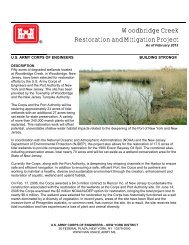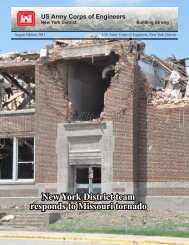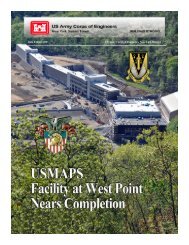The New York District Times - U.S. Army
The New York District Times - U.S. Army
The New York District Times - U.S. Army
- No tags were found...
Create successful ePaper yourself
Turn your PDF publications into a flip-book with our unique Google optimized e-Paper software.
On September 14, a Change of Command Cerermony for the U.S. <strong>Army</strong> Corps of Engineers, <strong>New</strong><strong>York</strong> <strong>District</strong> was held at the U.S. Custom House . In this ceremony, command of <strong>New</strong> <strong>York</strong> <strong>District</strong> wastransferred from Colonel John R. Boulé II, commander, to Colonel Paul E. Owen.<strong>The</strong> change of command ceremony is rooted in military history dating back to the 18th century duringthe reign of Frederick the Great of Prussia. At that time, organizational flags were developed with color arrangementsand symbols unique to each particular unit. To this flag and its commander, the soldiers of theunit dedicate their loyalty and trust. When a change of command was to take place, the flag was passed tothe individual assuming the command. This gesture was accomplished in front of the unit so that all couldsee and witness their new leader assuming his dutiful position. He who held the flag also held the soldier’sallegiance. This symbolic tradition has survived throughout military history.As a symbol of relinquishing command, Colonel Boulé, the outgoing commander, received the organizationalcolors from Mr. Joseph Seebode, the Deputy <strong>District</strong> Engineer for Programs and Project Managementand senior civilian for <strong>New</strong> <strong>York</strong> <strong>District</strong>. He then presented the colors to Colonel Kent Savre, NorthAtlantic Division Commander, who, in turn, presented them to Colonel Owen, the incoming commander.Colonel Owen then took responsibility for <strong>New</strong> <strong>York</strong> <strong>District</strong> by accepting the organizational colors.Colonel Owen then handed the colors back to Mr. Seebode, symbolizing the continuity and strength of thecivilian work force.Although this was a formalceremony a fond farewell wasgiven to Colonel Boulé whoretired from the U.S. <strong>Army</strong> aftermore than 26 years of dedicatedservice to the Nation.Since graduating from WestPoint in 1990, Colonel Owen’sservice has taken him to Germany,Afghanistan, California,Missouri, and twice to Iraq. Healso served as the deputy districtengineer for the Corps of EngineersChicago <strong>District</strong> and participatedin Hurricane Katrinarecovery efforts as the OperationsOfficer for the LouisianaRecovery Field Office.He comes to <strong>New</strong> <strong>York</strong><strong>District</strong> after serving at the U.S.<strong>Army</strong> War College as a Secretaryof Defense CorporateFellow with duties at CiscoSystems San Jose, Calif.<strong>New</strong> <strong>York</strong> <strong>District</strong> Building Strong Page 4®
tem Section, using lessons learned from Elders East,Elders West and Yellow Bar marsh islands are beingused to construct Black Wall and Rulers Bar marshislands through the beneficial use of dredged material.“One hundred and fifty-five thousand cubicyards of sand from Ambrose channel will be used torestore Black Wall resulting in 22.2 acres of marshand 95,000 cubic yards of sand to restore Rulers BarMarsh Island for an additional 12.2 acres of marsh,”said Weppler.was in the field constructing Yellow Bar. Agencies wereable to take advantage of already mobilized dredgesand sand placement infrastructure (pipeline) which wasexpected to result in a cost savings to the overall program.”<strong>The</strong> Gateway National Recreation Area is at the heartof Jamaica Bay and is a highly productive habitat thatsupports more than 300 species of birds, and over 100species of fish, marine animals and reptiles. <strong>The</strong>se speciesbreed and use the area as a nursery for juveniles,and hundreds of migratory birds that reside in the areaduring winter, and migratory birds that stop-over duringfall, and ‘fly way’ spring migrations.“Wetlands loss is a major concern in the Bay,” addedBaron, “We are very proud to be in a position to workwith other organizations and with <strong>New</strong> <strong>York</strong> State tobegin the monumental task of creating, restoring andconserving these habitats that are critical to our marineresources.”<strong>The</strong> complex has experienced greater wetlands lossthan almost anywhere else in the Bay and marsh islandhabitat continues to disappear at a rapid rate.“<strong>The</strong>se habitats are at the very core of a healthymarine system and it is critical to not only stop losingwetlands, but also start to rebuild them where they havedisappeared,” said Baron. “This type of restorationproject is essential if we are going to continue to enjoythe incredible marine resources we have in the Bay.”According to Peter Weppler, Chief, Coastal Ecosys-“<strong>The</strong>re is a considerable amount of engineeringconstruction that goes into a project like this, but themethod has a proven success at Elders East, West,Yellow Bar and others,” said Melissa Alvarez, ProjectBiologist.“<strong>The</strong> Bay is a particular area of concern, but weare committed to turning the tide on habitat loss thereand restoring it to its full potential.”Jamaica Bay and the Hudson Raritan Estuary ishome of the first urban National Park, a key componentand focus of the President’s America’s GreatOutdoors initiative. <strong>The</strong> Bay is recognized as a coastalhabitat deserving preservation and restoration, whichcontribute to sustaining and expanding the region’s nativeliving resources. <strong>The</strong> overall Hudson Raritan Estuarywas designated in 1988 as an Estuary of NationalSignificance, and more recently designated as a ‘GreatWater’ within the National “Great Waters” Campaign,and is one of the <strong>Army</strong> Corps’ priority ecosystems ofnational significance.“To maximize benefits, partners and funding weare using the sand from the HDP to remediates, restoreand protect the invaluable infrastructure within theestuary. After Black Wall and Rulers Bar sand placementare completed, the pipeline will be moved toPlumb Beach, <strong>New</strong> <strong>York</strong> to stabilize the shoreline andprotect the Belt Parkway,” added Baron.<strong>The</strong> <strong>Army</strong> Corps is just one of many partners inthis collaboration of Federal, <strong>New</strong> <strong>York</strong> State, <strong>New</strong><strong>York</strong> City, environmental, and private organizationsto revitalize the Hudson-Raritan Estuary in order toadvance the goals and targets of the broader HudsonRaritan Estuary Comprehensive Restoration Plan.<strong>New</strong> <strong>York</strong> <strong>District</strong> Building Strong ®Page 6
Federal Employee <strong>New</strong>s in BriefSequester: Civilian personnel in the Defense Department will be “seriously affected” if a budget sequestertakes effect next year, the Pentagon’s top budget official said recently. <strong>The</strong>re will be a “high probability”of both a hiring freeze and furloughs of current employees should Congress allow the sequestrationprocess to go forward, said Robert Hale, undersecretary of Defense and chief financial officerGovernment Credit Cards: Congress passed a bill to toughen oversight of agency purchasingcards, codifying new penalties on federal employees who abuse the cards. <strong>The</strong> bill requires agencies thatissue credit cards and convenience checks to, among other actions, improve record-keeping; train employeesin use of the cards; perform credit checks on employees issued cards; require prompt paymentsto avoid interest charges; invalidate cards for employees who depart the agency; and conduct periodicreviews of which employees should be issued the cards.Pay: On September 28, President Obama signed the continuing appropriations resolution that authorizesthe government to spend money for another six months. It is called the “Continuing AppropriationsResolution, 2013″ and it replaces the previous continuing appropriation resolution passed earlier thisyear. It continues funding the government until late in March 2013. In effect, this means that the existingpay freeze for federal employees will remain in effect, probably until the Spring of 2013. We do not, ofcourse, know what will happen after that time.Health Benefits: Federal Employees Health Benefits Program Premiums will rise 3.4 percent overallin 2013, the Office of Personnel Management said recently. But enrollees in FEHBP’s most popular plan— the Blue Cross Blue Shield standard option — will see minuscule increases next year. <strong>The</strong> averagedental coverage premium will go up less than 1 percent next year. Vision premiums will decline slightlyon average.Flexible Spending Accounts: Beginning next year, health care flexible spending accounts will becapped at $2,500, instead of $5,000. That reduction was mandated as part of the Affordable Care Acthealth care reform bill. Dependent care flexible spending accounts will remain capped at $5,000Open Season: <strong>The</strong> open season to sign up for health, dental and vision benefits and flexible spendingaccounts will go from Nov. 12 to Dec. 10. FEHBP will offer 230 health plans, up from 206 plan choicesavailable in 2012. OPM said 13 of those plans will be open to all eligible employees and retirees. OPMadded five new health maintenance organization plans this year.Thrift Savings Plan: <strong>The</strong> Federal Retirement Thrift Investment Board is in the early stages of decidingwhether or not to allow Thrift Savings Plan beneficiaries the ability to direct a portion of their assetsto private mutual funds. FRTIB is researching the option and will present a paper on the issue in the nextyear.<strong>New</strong> <strong>York</strong> <strong>District</strong> Building Strong Page 7®
<strong>Army</strong> Divers Perform Waterfront Repairsat Corp’s <strong>New</strong> Jersey Marine TerminalBy Vince Elias, Public AffairsWith the Manhattan skyline inthe distance, a specialized groupof Soldiers were busy during themonth of August working at the<strong>Army</strong> Corps’ Caven Point MarineTerminal located along the <strong>New</strong><strong>York</strong> Harbor in <strong>New</strong> Jersey.<strong>The</strong> Soldiers are <strong>Army</strong> diversfrom the 86th Engineer DiveDetachment home based in FortEustis, Va. who deployed to accomplishtraining, pier waterfrontinfrastructure operations, carpentry,surface and underwater cutting andjetting along the shoreline dockingfacilities used by the Corps’ marinefleet of vessels.<strong>Army</strong> divers and the Corps havea longstanding mutually-supportiverelationship and were once againeager to train on a wide variety oftasks and in the process, providedthe Corps with a high-quality product.<strong>The</strong> 86th Engineer Dive Detachment’ssupport to the operationallowed for real world training invarious mission essential collectiveand individual skill tasks. Capt.JohnPaul Navarro, Commander ofthe 86th Engineer Dive Team emphasizedthe importance of trainingand the work being performed.“<strong>The</strong> practical application of themission provided the divers with aunique opportunity to sharpenskills, stay mission ready, performpier side and underwater repairs, aswell as, perform dry dock and hullinspections of Corps watercraft,”said Navarro. “We’re jetting underneaththe dry dock – using a firehose to blast away sediment andmud that collects underneath thedry dock preventing it from operatingat its full range. <strong>The</strong> jetting isperformed every year by the diversat Caven Point.”<strong>The</strong> divers replaced deterioratedcross and lateral bracings used tomaintain the structural integrityof the piers, reattached damagedrubber bumpers that protect vesselsfrom the pier, and replaceddamaged sacrificial lumber whichprotects the structural lumber fromwave action and vessels.“We also removed nearly 125tons of floating debris using advancedunderwater equipment,such as the hydraulic chain sawand exothermic cutting torchwhich burns at 10,000 degrees,”added 1st. Lt. Ezra Swanson,Executive Officer, 86th EngineerDive Team.Staff Sgt. Chaise Turner,Platoon Sergeant, 86th EngineerDive Team added, “<strong>The</strong> team wasalso able to install 12 by 12 footlumber piles on the side of thepier that gets worn by vessels andwave action over time.”Col. Kent Savre, the <strong>Army</strong>Corps’ North Atlantic DivisionCommander met with the diversalong with Lt. Col. MichaelClancy, the <strong>Army</strong> Corps’ <strong>New</strong><strong>York</strong> <strong>District</strong> Deputy Commanderfollowing a tour of the six acrefacility accompanied by TomCreamer, Chief of Operations,<strong>New</strong> <strong>York</strong> <strong>District</strong> and WalterScott, Chief, Physical SupportBranch that operates and maintainsthe facility and manages theDrift and Floatables CollectionProject, and the Operations SupportBranch Survey Section performsbathymetric surveys. <strong>The</strong>group also visited the main building,Construction Division MetroArea Offices and the Kill vanKull Channel Deepening Projectoffices including a tour along thewaterfront. Savre also took the opportunityto meet with the diversand personally acknowledge theirefforts by presenting them with aCommander’s coin.<strong>New</strong> <strong>York</strong> <strong>District</strong> Building Strong ®Page 8
<strong>Army</strong> Corps and Partners Celebrate “Estuary Day”By Vince Elias, Public AffairsBalancing the Port and the environmentare two components of aworld class estuary – and on October12, 2012 an alliance of partnerswith the support of elected officialsconveyed this important initiativeto hundreds of area school studentsat the 10th annual Estuary Daycelebration.Held near the Elizabeth River atthe Peterstown Community Centerin Elizabeth, <strong>New</strong> Jersey, studentsarrived by the bus load in whatturned out to be a very successfulinteractive experience.Orchestrated by Future CityInc., and sponsored by the ElizabethRiver/Arthur Kill WatershedAssociation, the event’s success isattributed to a concerted effort andsteadfast partnership with stronglocal support. <strong>The</strong> program demonstratedthe importance of educationand community participationin preserving the environment.Partnering organizations includedthe Elizabeth River/ArthurKill Watershed Association, Cityof Elizabeth mayor’s office, U.S.<strong>Army</strong> Corps of Engineers, U.S.Coast Guard, U.S. EnvironmentalProtection Agency-Harbor EstuaryProgram, <strong>New</strong> Jersey State Departmentof Environmental Protection,NY/NJ Baykeeper, Green Infrastructureand support from the officesof U.S. Sen. Robert Menendezand Rep. Albio Sires (NJ-13).In a setting which was not atypical classroom, participatingagencies staffed table displays andserved as instructors, discussingwith students their respective organization’smission as it relates tothe port, harbor, estuary and aboutenvironmental stewardship.Commitment to selfless-serviceis one of the <strong>Army</strong>’s core values,and volunteers from the <strong>Army</strong>Corps’ <strong>New</strong> <strong>York</strong> <strong>District</strong> exemplifiedthis value by sharing theirexpertise with students and affordingthem an opportunity to bettercomprehend the history of the estuaryand its environmental state.Using a variety of visual aids,William Slezak, Chief of the <strong>Army</strong>Corps’ <strong>New</strong> <strong>York</strong> Harbor Programsalong with Lisa Baron, marinebiologist lectured at the Corps’ educationworkshops about the <strong>New</strong><strong>York</strong> and <strong>New</strong> Jersey harbor estuaryand the significance of balancingthe Port and the environment,ecosystem restoration and activitiesassociated with restoration projectsand studies.Melissa Alvarez, Lisa Baron,Chonteau Johnson, Amanda Switzerand Thomas Wyche staffedthe live marine animal interactiveexhibit as Stephen Knowles interactedwith students nearby at hismodel of an estuary exhibit.“<strong>The</strong> <strong>Army</strong> Corps and its partnershave many roles, and focuson improving the <strong>New</strong> <strong>York</strong> and<strong>New</strong> Jersey Harbor Estuary. Thisis another great opportunity tolearn about the Estuary,” saidSlezak at the opening ceremony.“It is our hope that each and everyone of you can leave from today’sworkshops with a little bit moreknowledge about the estuary andways we can affect changes in ourwatershed.”“Estuaries are national treasures-- vital ecological and communityresources whose health affects ourhealth and the vibrancy of our communitiesand economy,” said Baronwho has been a participant for thepast five years. “Estuary Day 2012was another fabulous event that exemplifiedstrong partnership with acommon goal to inform our futureleaders about the importance ofsustaining and improving the healthof the estuary.”It was especially rewarding forthe Corps and another opportunityto provide pupils with informationabout the Corps its many environmentalinitiatives in the region. Bysharing their knowledge, volunteersimparted how important the estuaryis to the region and the nationand students were able to take withthem their newfound knowledge toshare with their friends and familieson what they experienced andlearned at Estuary Day.<strong>New</strong> <strong>York</strong> <strong>District</strong> Building Strong ®Page 9
On October 2, 2012 the U.S. <strong>Army</strong> Corps of Engineers, <strong>New</strong> <strong>York</strong> <strong>District</strong> was nominated as an ideal employmentpartner in federal government by providing employment opportunities for individuals with disabilities.Each year during National Disability Employment Awareness Month a celebration is held to recognizeoutstanding employers who have excelled at instituting programs that have enhanced the vocational rehabilitation,independent living services and business services needed by persons with disabilities.Nominated by Abilities, Inc. the Corps was recognized for the continuing efforts of Estelle Capowski andJean Lau , EEO, in supporting business skills training for member of Abilities Inc.Working with the staff of Abilities, Iinc. curriculum development was enhanced and new and innovativeskills and training programs were developed to meet the needs of employersin a challenging job market. Capowski provided practice humanresource interviews on a quarterly basis for the Business Skills trainingparticipants and Lau recently did “Career Couching” on networking andresume writing. <strong>The</strong>se coaching sessions have resulted in increased jobplacements and increased hiring opportunities for individuals with disabilities.Estelle Capowski, Jean Lau, of EEO,along with Michael Dolan, ProgramManager, Abilities.org<strong>New</strong> <strong>York</strong> <strong>District</strong> Page 10Building Strong ®
Building Strong means Building SafeBy JC DelgadilloAfghanistan Engineer <strong>District</strong><strong>The</strong> U.S. <strong>Army</strong> Corps of Engineers believes a safe work environment is a basic right. Throughout the AfghanistanEngineer <strong>District</strong>-South area of operations,where dozens of Afghan National SecurityForces installations are under construction, safetyand occupational health specialists visit job sitesdaily to make sure laborers are protected fromunnecessary risks.“A person ought to be able to go to work, earna living and return in the same condition he lefthome in, said Bruce Barrett, Chief of Safety andOccupational Health for the Afghanistan Engineer<strong>District</strong>-South.Jeff Ice, a safety and occupational health specialist who deployedto Kandahar from the USACE <strong>New</strong> <strong>York</strong> <strong>District</strong> shows an Afghanconstruction worker how to detect a fake fire extinguisher. Somecounterfeit ones, instead of releasing the normal fire-stoppingagent they are supposed to release, spit out flour or other noneffectivesubstances. (Photo by JC Delgadillo)<strong>The</strong> safety of the Afghan people and Coalitionforces continues to be the highest priority forNATO’s International Security Assistance Force.<strong>The</strong> USACE is building dozens of high-qualityfacilities throughout Afghanistan where AfghanNational Security Forces will live, work andtrain. Construction is one of the most dangerousindustries, not only in Afghanistan, but worldwide.As such, safety and occupational health specialists inspect sites, equipment, and practices to ensure safetystandards and regulations are followed.“Nobody should have to labor in a reckless environment,” said Barrett, who deployed to Kandahar from theUSACE Southwestern Division where he serves as the Division’s Chief of Safety and Occupational Health.Barrett has more than 40 years experience in the industry and has managed the Safety and Occupational Healthprograms to excellence at four of the nine divisions and several of the <strong>District</strong>s within USACE.“<strong>The</strong> people of Afghanistan have suffered decades of conflict which has ravaged the country’s public infrastructureand resulted in a deteriorated construction industry and a weak safety and occupational health program,”explained Geronimo Gomez, a safety and occupational health specialist with more than 35 years experiencemaking workplaces healthier and safer. Gomez has taught safety and occupational health courses at theUniversity of Texas and served at the Occupational Safety and Health Administration, too.continued on page 12<strong>New</strong> <strong>York</strong> <strong>District</strong> Page 11Building Strong ®
Common hazards for construction laborers include falls, trench collapse, electrocution, failure to use proper personal protectiveequipment, scaffold collapse and repetitive motion injuries.“I look at scaffolding, fall protection, ladders, electrical work, excavations, protective systems and much more when I’mat a site,” said Jeff Ice, a safety and occupational health specialist who deployed to Kandahar from the USACE <strong>New</strong> <strong>York</strong><strong>District</strong>. “I observe the workers, I check their equipment, I ask questions and I listen,” he said.For Ice, a former construction worker who survived a life-altering fall on a job site that resulted in disability, safety ispersonal. Ice, who has worked for the USACE since 2010, holds a master of science in safety management and in 2012, wonthe <strong>New</strong> <strong>York</strong> Federal Executive Board Emergency Preparedness and Employee Safety Award, as well as the <strong>District</strong> Safetyperson of the year. One of the most important aspects of his job is recommending measures to help protect workers fromhazards. With some Afghan-owed companies, years of war and neglect have created an education and skills deficit. Somecontractors simply don’t know how, don’t know that they must, or don’t care to provide safe work environments for theirstaff.“Safety and occupational health is influenced by social, economic, and cultural factors,” said Ice.In addition to inspecting sites, Ice educates companies about the benefits of maintaining a good safety and occupationalhealth program. Benefits which include reduced absenteeism due to illness or injury, less lost days, overall costs savings andmost importantly, less fatalities. “It’s about protecting lives. Every worker’s life matters and we simply can’t construct thesefacilities that will benefit Afghan citizens if we don’t create the conditions for a healthy and safe work environment too,”said Ice.For more information about the standards and regulations governing USACE workplace safety and occupational health,check out the USACE Safety and Health Requirements Manual, EM 385-1-1.<strong>New</strong> <strong>York</strong> <strong>District</strong> Page 12Building Strong ®













